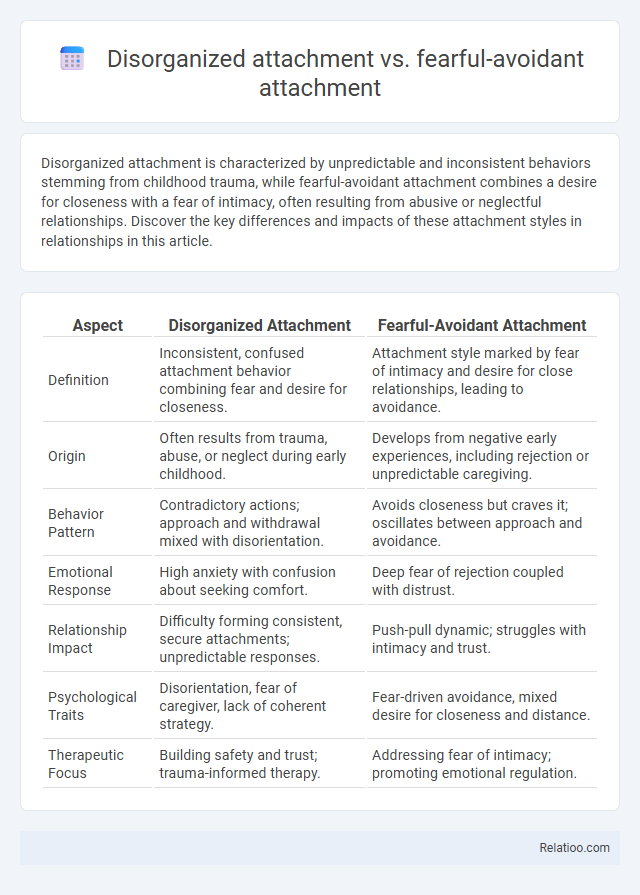Disorganized attachment is characterized by unpredictable and inconsistent behaviors stemming from childhood trauma, while fearful-avoidant attachment combines a desire for closeness with a fear of intimacy, often resulting from abusive or neglectful relationships. Discover the key differences and impacts of these attachment styles in relationships in this article.
Table of Comparison
| Aspect | Disorganized Attachment | Fearful-Avoidant Attachment |
|---|---|---|
| Definition | Inconsistent, confused attachment behavior combining fear and desire for closeness. | Attachment style marked by fear of intimacy and desire for close relationships, leading to avoidance. |
| Origin | Often results from trauma, abuse, or neglect during early childhood. | Develops from negative early experiences, including rejection or unpredictable caregiving. |
| Behavior Pattern | Contradictory actions; approach and withdrawal mixed with disorientation. | Avoids closeness but craves it; oscillates between approach and avoidance. |
| Emotional Response | High anxiety with confusion about seeking comfort. | Deep fear of rejection coupled with distrust. |
| Relationship Impact | Difficulty forming consistent, secure attachments; unpredictable responses. | Push-pull dynamic; struggles with intimacy and trust. |
| Psychological Traits | Disorientation, fear of caregiver, lack of coherent strategy. | Fear-driven avoidance, mixed desire for closeness and distance. |
| Therapeutic Focus | Building safety and trust; trauma-informed therapy. | Addressing fear of intimacy; promoting emotional regulation. |
Introduction to Attachment Styles
Disorganized attachment is characterized by contradictory behaviors and confusion in relationships, often stemming from early trauma or inconsistent caregiving. Fearful-avoidant attachment, a subset of disorganized attachment, combines a desire for closeness with deep fear of intimacy and rejection, leading to avoidance and ambivalence in relationships. Understanding these attachment styles is crucial for recognizing patterns of emotional regulation and interpersonal challenges rooted in childhood experiences.
Understanding Disorganized Attachment
Disorganized attachment emerges from inconsistent caregiver responses, leading to a conflicting desire for closeness paired with fear of rejection or harm. Fearful-avoidant attachment, a subtype of disorganized attachment, is characterized by ambivalence and mistrust, where individuals long for intimacy but avoid it due to fear of vulnerability. Understanding disorganized attachment aids in recognizing patterns of emotional dysregulation and relational difficulties rooted in early childhood trauma or neglect.
Defining Fearful-Avoidant Attachment
Fearful-avoidant attachment is characterized by a desire for close relationships coupled with a deep fear of rejection, leading to inconsistent and unpredictable behaviors. Unlike disorganized attachment, which stems from a lack of clear strategy in managing relational stress, fearful-avoidant attachment involves a paradoxical mix of approach and avoidance driven by fear of intimacy and mistrust. This attachment style often results from childhood trauma or neglect, impacting emotional regulation and interpersonal dynamics in adulthood.
Key Differences Between Disorganized and Fearful-Avoidant Attachment
Disorganized attachment is characterized by a lack of a coherent strategy to deal with attachment stress, often resulting from inconsistent or frightening caregiving, leading to confusion and anxiety in relationships. Fearful-avoidant attachment, a subtype of disorganized attachment, manifests as a desire for closeness hindered by fear of rejection or harm, causing individuals to avoid intimacy despite craving connection. The key difference lies in fearful-avoidant attachment's clear pattern of approach-avoidance conflicting behaviors, whereas disorganized attachment broadly reflects fragmented and contradictory responses without a consistent coping strategy.
Common Origins and Causes
Disorganized and fearful-avoidant attachment styles commonly originate from early childhood experiences characterized by inconsistent or frightening caregiving, often involving abuse, neglect, or trauma. These attachment patterns develop when a child simultaneously experiences the caregiver as a source of comfort and fear, leading to confusion and difficulty in forming coherent attachment strategies. Both styles reflect disruptions in the attachment system caused by unresolved trauma and emotional dysregulation affecting future interpersonal relationships.
Emotional and Behavioral Signs
Disorganized attachment is characterized by contradictory behaviors such as simultaneously seeking and avoiding comfort, often leading to confusion and anxiety in relationships. Fearful-avoidant attachment combines a deep fear of rejection with a strong desire for closeness, resulting in emotional instability and avoidance behaviors that sabotage intimacy. Understanding these emotional and behavioral signs can help you recognize patterns in your relationships and work towards healthier attachment styles.
Impact on Adult Relationships
Disorganized attachment and fearful-avoidant attachment both contribute to instability and mistrust in adult relationships, often leading to emotional withdrawal and difficulty in forming secure bonds. Individuals with disorganized attachment may exhibit contradictory behaviors, such as seeking closeness while simultaneously fearing intimacy, which creates confusion and conflict within partnerships. Fearful-avoidant attachment intensifies these dynamics through deep-seated fears of rejection and abandonment, resulting in a persistent struggle to achieve emotional closeness and mutual trust.
Assessment and Identification Methods
Assessment and identification of disorganized attachment often involve structured observational methods like the Strange Situation Procedure, which reveals inconsistent and contradictory behaviors in children. Fearful-avoidant attachment is typically diagnosed through adult attachment interviews and self-report questionnaires that uncover patterns of fear of intimacy combined with avoidance behaviors. Distinct from other attachment styles, disorganized attachment features a lack of coherent strategy in coping with relational stress, identified by coding behavioral and physiological responses during attachment-related assessments.
Therapeutic Approaches and Interventions
Therapeutic approaches for disorganized attachment focus on creating safety and stability through trauma-informed care, emphasizing emotional regulation and building secure relational patterns. Fearful-avoidant attachment interventions prioritize gradual exposure to emotional intimacy and fostering trust within a consistent therapeutic relationship to reduce fear and avoidance responses. Your therapy may incorporate techniques such as somatic experiencing, cognitive-behavioral therapy (CBT), and attachment-based interventions to address underlying trauma and promote attachment repair.
Healing and Building Secure Attachments
Healing disorganized attachment involves consistent, empathetic caregiving that fosters safety and trust while addressing trauma through therapeutic interventions like EMDR or somatic therapy. Fearful-avoidant attachment requires building emotional regulation and self-awareness to reduce fear of intimacy and abandonment, often through attachment-based therapy and mindfulness practices. Strengthening secure attachments hinges on nurturing reliable, responsive relationships and practicing open communication to create a foundation of emotional security and resilience.

Infographic: Disorganized attachment vs Fearful-avoidant attachment
 relatioo.com
relatioo.com